28
Zener diode is a kind of diode that can stabilize the voltage in the circuits, which uses the phenomenon that the current varies greatly while the voltage is basically constant when the pn junction is in the state of reverse breakdown. It can maintain a very high resistance before the critical reverse breakdown point. At this point, the reverse resistance is reduced to a small value. In this low-resistance region, the current increases while the voltage remains constant. Because of this characteristic, the zener diode is mainly used as a voltage regulator or voltage reference component. Zener diodes can be connected in series for use at higher voltages to obtain higher regulated voltages.
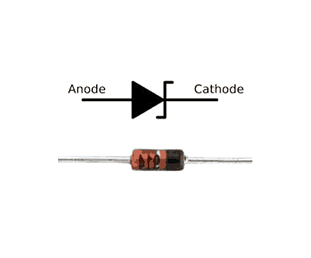
Zener Diode and Its Symbols
Catalog
I Principle of Zener Diode | |
II Main Parameters of Zener Diode | 2.1 Uz - Stable Voltage |
2.2 Iz - Rated Current | |
2.3 Rz—Dynamic Resistance | |
2.4 Pz - Rated Power Consumption | |
2.5 α---Temperature Coefficient | |
2.6 IR - Reverse Leakage Current | |
III Identification of Zener Diode | 3.1 Identification of Positive and Negative Polarity |
3.2 Identification of Color Wheel Zener Diode | |
3.3 Identification of Zener Diode and Rectifier Diode | |
IV Application of Zener Diode | 4.1 Series Voltage Regulation Circuits |
4.2 Over-voltage Protection Circuit in TVs | |
4.3 Arc Suppression Circuits | |
V Forward and Reward Series Connection of Zener Diode | |
I Principle of Zener Diode
The forward characteristics of the volt-ampere characteristic curve of the zener diode are similar as a general purpose diode. And when the reverse voltage is lower than the reverse breakdown voltage, the reverse resistance is large and the reverse leakage current is extremely small. However, when the reverse voltage is close to the critical value, the reverse current will suddenly increase, called breakdown, and the reverse resistance will suddenly drop to a small value. Therefore, although the current varies over a wide range, the voltage across the diode is substantially stabilized near the breakdown voltage, thereby realizing the voltage stabilizing.
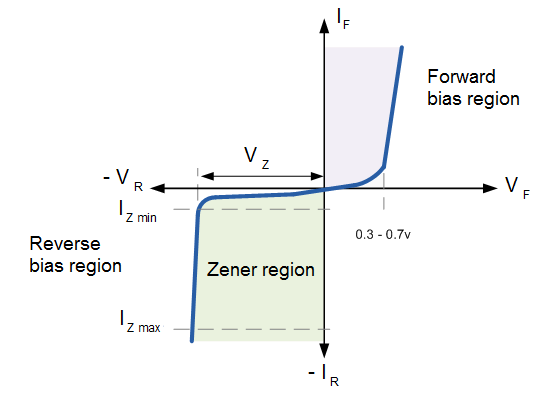
Characteristics Curve of Zener Diode
II Main Parameters of Zener Diode
2.1 Uz— Stable Voltage
It refers to the stable voltage value generated by the two ends of the zener diode when the rated current pass through it. This value varies slightly with the operating current and temperature. And due to the difference in manufacturing process, the voltage regulation values of the same type of zener are not exactly the same. For example, the 2CW51 regulator has a Vzmin of 3.0V and a Vzmax of 3.6V.
2.2 Iz— Rated Current
It indicates the current value passing through the tube when the voltage regulator generates a stable voltage. If the current is below this value, the voltage regulation effect will be worse, and it is allowed to be above this value as long as the rated power loss is not exceeded, and the voltage regulation performance will be better, but at the same time, more power is consumed.
2.3 Rz—Dynamic Resistance
It’s the ratio of the voltage change to the current change across the zener diode, which varies with the operating current. Generally, the larger the operating current is, the smaller the dynamic resistance will be. For example, the operating current of the 2CW7C zener diode is 5mA, and its Rz is 18Ω. When the operating current is 1OmA, Rz is 8Ω. And when it is 20mA, Rz is 2Ω.And if it exceeds 20mA, the value will be basically constant.
2.4 Pz— Rated Power Consumption
It is determined by the allowable temperature rise of the chip, and its value is the product of the stable voltage Vz and the maximum allowable current Izm. For example, if the Vz of the 2CW51 zener diode is 3V and its Izm is 20mA, the Pz of the diode is 60mWo.
2.5 α—Temperature Coefficient
If the temperature of the Zener diode changes, its stable voltage will also change slightly. The relative changing value of the voltage across the tube caused by the temperature change of 1°C is the temperature coefficient (unit: %/°C).
Generally speaking, we call the voltage regulation value below 6V zener breakdown, and under the circumstances, the temperature coefficient of the diode is negative. Avalanche breakdown occurs when the voltage regulation value is higher than 6V, and the temperature coefficient is positive.
When the temperature rises, the depletion layer decreases. In the depletion layer, the energy of the valence electrons of the atom rises, and electric field with smaller intensity can excite the valence electrons from the atoms to generate zener breakdown, so the temperature coefficient is negative. When the depletion layer is wide with a intensive electric field, the increasing temperature will causes the vibration amplitude of the lattice atoms to increase, which hinders the movement of carriers, generating avalanche breakdown. In this case, avalanche breakdown can only occur when the reverse voltage is increased, so the temperature coefficient of the avalanche breakdown is positive. This is why the voltage regulation value of a zener diode with a voltage regulation value of 15V gradually increases with temperature, and the voltage regulation value of a zener diode with voltage regulation value of 5V gradually decreases with the temperature. For example, the temperature coefficient of the 2CW58 zener diode is +0.07%/°C, that is, for every 1°C increase in temperature, the voltage regulation value will increase by 0.07%.
When there is a high requirements for the power supply, two zener diodes with opposite temperature coefficients can be connected in series as compensation. Due to mutual compensation, the temperature coefficient is greatly reduced to 0.0005%/°C.
Temperature Coefficient of Zener Diode
2.6 IR— Reverse Leakage Current
It refers to the leakage current generated by the zener diode at the specified reverse voltage. For example, when VR of 2CW58 zener diode is 1V, its IR is O.1uA. And when its VR is 6V, IR becomes 10uA.
III Identification of Zener Diode
3.1 Identification of Positive and Negative Polarity
From the appearance, the positive end of the metal-packed zener diode body is planar, and the negative end of the body is in a semi-circular shape. For the plastic-packed zener diode, the end printed with a colorful mark is negative, and the other end is a positive. And for the zener diode with unclear mark, a pointer multimeter can be used. The measurement method is the same as that of the general purpose diode.
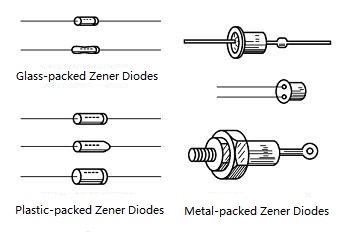
Different Packing Types of Zener Diode
First connect the two test leads of the multimeter to the two electrodes of the zener diode by the “R×1k” gear, and then measure the resistance. Next, exchange the two test leads and measure the resistance again. Of the two measurement results, the resistance value is the smaller when the black test lead is connected to the positive pole of the zener diode, and the red meter is connected to the negative pole of the zener diode.
3.2 Identification of Color Wheel Zener Diode
Color Wheel Zener Diodes are commonly seen in Japanese products. Generally, they are marked with the model number and parameters, and detailed information can be found in the components manual. They are of small size, low power, and the voltage regulation value is mostly within 10V, which makes them easily broken down and damaged. Many people will mix the color wheel zener diodes with the color wheel resistors for their similar appearances.
The color wheel on zener diodes have two meanings: one is the number and the other are the decimal places (usually the color wheel zener diodes all reserve one decimal fraction, expressed in brown. It can also be understood as the magnification is ×10-1.
Due to the small size of the zener diodes with small power, it is difficult to mark the model number on the tubes, so some products use the color wheel to indicate their nominal stable voltage value. Like the color wheel resistors, there are colors of brown, red, orange, yellow, green, blue, purple, gray, white, and black in the wheel of the color wheel zener diodes, which are used to respectively represent the values of 1, 2, 3, 4, 5, 6, 7, 8, 9, and 0.
Some zener diodes have only 2 color wheels, while others have 3. The first wheel is closest to the negative electrode, and the second ring and the third ring are sequentially followed.
If there are only 2 color wheels, the nominal stable voltage value of the zener diode is a two-digit number, which is "××V" (tens of volts). The first wheel represents the value at the tens place of the voltage, and the second wheel represents the value at the ones place. For example, if the color of the first and second wheels are red and yellow, the nominal stable voltage value is 24V.
If there are 3 color wheels, and the second and third color wheel are of the different colors., then the nominal stable voltage value is a one-digit integer with one decimal, which is “×.× V”. The first ring represents the voltage value at the ones place. The second and third color wheels (of the same color) together represent the value at the tenths place (first place after the decimal point). For example, the colors of the first, second, and third wheels are gray, red, and red, then the nominal stable voltage value is 8.2V.
And if there are 3 color rings, and the 2nd and 3rd color rings are different in color, the nominal stable voltage value is a two-digit integer with one decimal, which is "××.× V". The first wheel represents the voltage value at the tens place. The second wheel represents the value in the ones place. And the third wheel represents the value at the tenths place (first place after the decimal point). However, this situation is rare.
3.3 Identification of Zener Diode and Rectifier Diode
A multimeter is needed to find out their differences. First, use the gear of “R×1K” on the multimeter to judge the positive and negative electrodes of the zener diode. Then change the gear to “R×10K”, and respectively connect the black test lead and the red test lead to the negative pole and the positive pole of the zener diode. At this moment, if the reverse resistance value measured is much smaller than the reverse resistance value measured with the gear of “R×1K”, it indicates that the diode under test is a zener diode. Conversely, if the measured reverse resistance value is still large, the diode is a rectifier diode or a detector diode.
Here is the principle of this identification method. the voltage of the battery used inside the gear of R×1K is 1.5V, which seldom cause the reverse breakdown, making the measured resistance value relatively large. When we use the “R×10K” gear, the voltage of the internal battery of the multimeter is generally above 9V. And if the measured tube is a zener diode, the reverse breakdown will occur, greatly reducing the resistance value. However, if the tube to be tested is a rectifier or detector diode, the measured resistance will not be very different from each other regardless of whether it is measured with “R×1K” or “R×10K” gear.
Notes: When the voltage regulation value of the zener diode is higher than the voltage value of “R×10K” gear of the multimeter, this method cannot be carried out.
Properties of Zener Diode and Rectifier Diode
IV Application of Zener Diode
4.1 Series Voltage Regulation Circuits
In the circuit of the first picture, the base electrode of the transistor T is stabilized.
When the voltage of the diode D is stabilized at 13V, then the emitter outputs a constant voltage of 12.3V(13-0.7=12.3V). Within a certain range, regardless of the rises or falls of the input voltage and the load resistance, the output voltage remains unchanged.
This circuit is used in many situations. The 7805 is a series integrated voltage regulation circuit that can output a voltage of 5V. The 7805-7824 can output voltages of 5V to 24V, which are used for many electrical appliances.
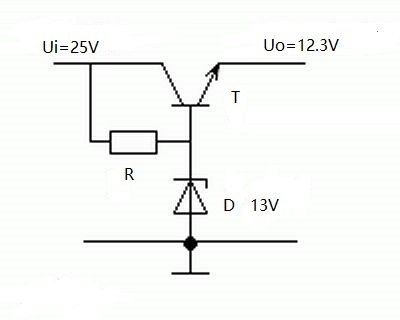
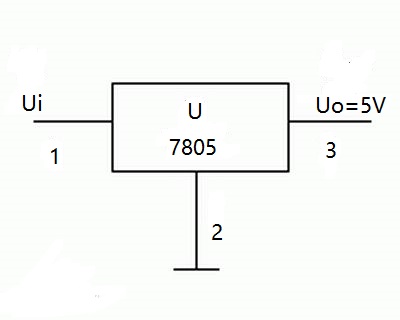
Series Integrated Voltage Regulation Circuit of 7805
4.2 Over-voltage Protection in TVs
In the figure below, 115V is the main power supply voltage of the TV. When the output voltage of the power supply is too high, D is turned on, and then transistor T is turned on. The collector potential of the transistor T will change from the original high level of 5V to a low level, and the voltage passing through the standby control line will put the TV into the state of standby protection.
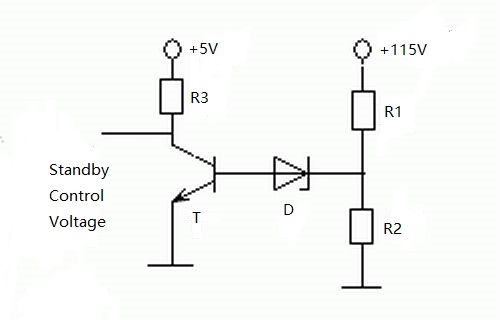
4.3 Arc Suppression Circuits
If a suitable zener diode(or a normal diode) is connected in parallel to the inductance coil, as shown belowthe high voltage generated by the release of the electromagnetic energy is used by the diode when the coil is turned off in the conducting state. So when the switch is turned off, the arc of the switch is eliminated. This application circuit is more frequently used in the industries, such as some high-power electromagnetic control circuits.
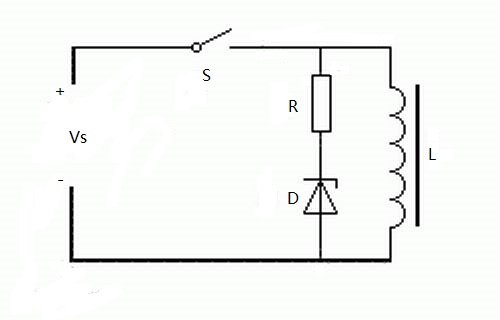
V Forward and Reward Series Connection of Zener Diode
If the two zener diodes are reversely connected in series, the voltage is clamped when the forward and reverse voltages reach the voltage regulation value, which means the voltage will not rise any more.
Frequently, a zener diode is connected at the emitter junction of the grid G and the source S in the amplifier circuits of large power. By limiting the voltage, we can protect the insulating layer between G and S from being broken down by excessive voltage.
When the two diodes are reversely connected in series, they can provide overvoltage protection to the circuit they connected to in parallel. When there is an over voltage in the circuit, the diodes will be firstly broken down and shorted.
You May Also Like:
Versions, Development Platforms, and Installation Sequence of Device Driver
Parameters, Classifications and Applications of Light Emitting Diode(LED)
Features, Developemnt Trends and Disadvantages of Wireless Power Transfer
Ordering & Quality
| Photo | Mfr. Part # | Company | Description | Package | Qty |
|
MPC8280VVQLDA | Company:NXP / Freescale | Remark:IC MPU MPC82XX 333MHZ 408TBGA | Package:480-LBGA |
MPC8280VVQLDA Datasheet |
In Stock:744 Inquiry |
Inquiry |
|
S9S12G128F0CLH | Company:NXP | Remark:IC MCU 16BIT 128KB FLASH 64LQFP | Package:64-LQFP |
S9S12G128F0CLH Datasheet |
In Stock:5046 Inquiry |
Inquiry |
|
RHC2512FT150R | Company:Stackpole Electronics | Remark:RES SMD 150 OHM 1% 2W 2512 | Package:2512 (6432 Metric) |
RHC2512FT150R Datasheet |
In Stock:19360 Inquiry |
Inquiry |
|
MC9S12C64CFAE | Company:NXP / Freescale | Remark:IC MCU 16BIT 64KB FLASH 48LQFP | Package:48-LQFP |
MC9S12C64CFAE Datasheet |
In Stock:615 Inquiry |
Inquiry |
|
MC9S08QA2CFQE | Company:NXP | Remark:IC MCU 8BIT 2KB FLASH 8QFN | Package:8-VDFN Exposed Pad |
MC9S08QA2CFQE Datasheet |
In Stock:25275 Inquiry |
Inquiry |
|
70V7599S166BCI8 | Company:IDT | Remark:SRAM 128K x 36 Synchronous Bank-Switchable Dual-Port SRAM | Package: |
70V7599S166BCI8 Datasheet |
In Stock:2 Inquiry |
Inquiry |
|
1N4148W-7-F | Company:Diodes Incorporated | Remark:DIODE GEN PURP 100V 300MA SOD123 | Package:SOD-123 |
1N4148W-7-F Datasheet |
In Stock:5270000 Inquiry |
Inquiry |
|
MBRS130LT3G | Company:ON Semiconductor | Remark:DIODE SCHOTTKY 30V 2A SMB | Package:SMB |
MBRS130LT3G Datasheet |
In Stock:516247 Inquiry |
Inquiry |
|
MC68908GZ8MFAE | Company:NXP | Remark:IC MCU 8BIT 8KB FLASH 48LQFP | Package:48-LQFP |
MC68908GZ8MFAE Datasheet |
In Stock:106 Inquiry |
Inquiry |
|
MCIMX6U7CVM08AC | Company:NXP / Freescale | Remark:IC MPU I.MX6DL 800MHZ 624MAPBGA | Package:624-LFBGA |
MCIMX6U7CVM08AC Datasheet |
In Stock:95 Inquiry |
Inquiry |